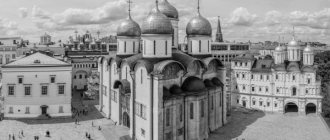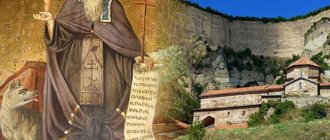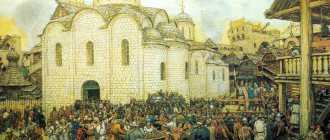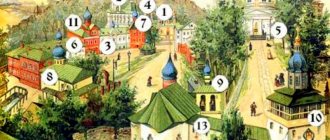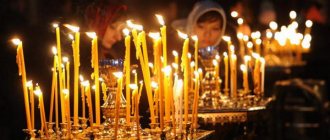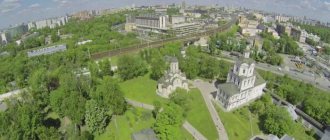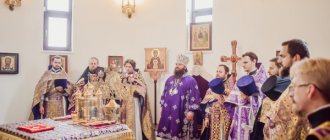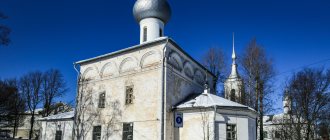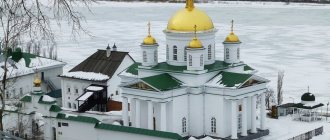About the temple
One of the most revered saints among the people
is
the Venerable Seraphim of Sarov
. Both in life and in prayerful intercession, the ascetic of Sarov is close to the soul of an Orthodox person; he invisibly remains with him in his sufferings, trials and hopes.
On November 25, 1825, the Most Holy Theotokos, accompanied by St. Clement and St. Peter of Alexandria, appeared to St. Seraphim of Sarov. Coming out of seclusion at the command of the Mother of God, the Reverend, knowing the past and foreseeing the future, gave spiritual advice, filled with wisdom and goodness.
The Monk Seraphim is especially revered in our church.
Every Tuesday in the evening,
an akathist is read
before the ancient image of this saint of God .
In the temple there is a list of the icon of the Mother of God called “Kykkos”
. In the ancient Kykkos image of the Most Holy Theotokos, written by the holy Apostle and Evangelist Luke, who was worthy of Her blessing and favored by Her, the Most Holy Virgin is depicted holding the Infant God, Her Son, on her right hand. This iconographic version is called “Eleusa”, that is, “Merciful”. Later this icon became known as the Gracious-Kykkos icon.
Every Wednesday evening
In the Church of All Saints on Kulishki,
an akathist to the Most Holy Theotokos is performed
in honor of Her “Kykkos” icon.
Special veneration
in the All Saints Church
it is given to the saint and wonderworker Nicholas, Archbishop of Myra
.
While performing the Sacrament of the Priesthood over the future saint, the bishop, filled with the Holy Spirit, prophetically predicted to the people the great future of this saint of God:
“Behold, brothers, I see a new sun rising over the ends of the earth, which will be a consolation to all who are sad. Blessed is the flock that is worthy to have such a shepherd! He will feed well the souls of the lost, feeding them in the pastures of piety; and he will be a warm helper to everyone in trouble!”
During his lifetime, Saint Nicholas was a benefactor of the human race; He did not cease to be one even after his death. The Lord granted his honest body incorruptibility and special miraculous power. His relics began - and continue to this day - to exude fragrant myrrh, which has the gift of working miracles. And now, reclining with a particle of his holy relics in the Church of All Saints on Kulishki, he, as in the past, receives believers with love and cordiality, being a father for orphans, a nourisher for the poor, a comforter for those who cry, and an intercessor for the oppressed.
The Orthodox Church honors the memory of St. Nicholas not only on December 19 and May 22, but also weekly, every Thursday.
Likewise, in the Moscow All Saints Church, every Thursday in the St. Nicholas chapel, in front of the venerated image of St. Nicholas, one can venerate a piece of his holy relics: the ark is taken out for veneration after the end of the Divine Liturgy and remains in the church until 20:00. In the evening of this day, an akathist to the saint of God is performed.
From the Vatopedi Monastery from Holy Mount Athos, an icon was donated as a blessing to the Church of All Saints on Kulishki - a copy of the miraculous image of the Mother of God “The All-Tsarina”
.
The image of the Mother of God “The Queen of All” became famous for many miracles
and healings from serious illnesses.
Believers especially earnestly pray to the Mother of God
in front of this icon with requests
for help in the treatment of cancer
.
Every Friday
at our church
with the reading of an akathist to the Most Holy Theotokos
in front of Her icon “The All-Tsarina.” At the end of the service, consecrated oil from the lamp from this revered image is distributed to everyone.
All Saints Church also contains other famous and revered shrines:
- A crucifix that is a true work of art;
- Icon of the Mother of God "Tikhvin";
- Icon of the Most Holy Theotokos “The Sign”;
- Icon of the Most Holy Theotokos “Hodegetria-Sumela”;
- Icon of the Mother of God “Merciful”;
- Icon of the Great Martyr and Healer Panteleimon;
- Icon of Saints Joachim and Anna with particles of their relics;
- Icon of St. Apostle and Evangelist John the Theologian;
- Icon of St. Spyridon of Trimifuntsky;
- Icon of St. Luke of Crimea;
- Icon of the holy righteous John the Russian with part of his cover;
- Martyr icon. Andrey Stratilat.
Neighborhoods of Mitino in the 14th–16th centuries
In the old days, within the boundaries of the modern Mitino district there were a number of villages: in addition to the village of Mitino itself, these were the villages of Rozhdestveno and Spasskoye, the villages of Penyagina, Priezdova and many others. To the northwest of them were the villages of Angelovo, Maryino, Aristovo, Saburovo, to the west - Gubaylovo, Chernevo, to the southwest - Pavshino, to the east - Tushino, to the northeast - the village of Bratsevo, the village of Putilkovo, etc. (see the diagram we made on the basis of maps from the book: Kusov V.S. Lands of the Moscow province in the 18th century: Maps of counties. Descriptions of land holdings. M., 2004. T. 1–2).
Scheme from the book by V. S. Kusov
According to written sources, the history of most of them can be traced back to the 16th century, and some - even to the 14th century, thanks to the connection of the owners of certain villages with the grand ducal family (according to archaeological data, as we have already seen, the history of the presence of people in these places goes back much further. further). Here or nearby, the noble boyars Fyodor Byakont, a close friend of the holy noble prince Daniil of Moscow, and Nester Ryabets, whose son and grandson were associates of Daniil’s son and great-grandson, Ivan Ι Danilovich Kalita and Dmitry I Ivanovich Donskoy, received their estates. Some local villages became part of the inheritance even of the Grand Duchess personally and the younger descendants of the Grand Duchess. By the end of the 16th century, however, almost all of these lands became church property - we will see below how this happened.
I. Native places of St. Alexis?
Fyodor Byakont belonged to the highest aristocracy of the ancient Chernigov principality, which in 1239 was devastated by the troops of Mengu-Timur and by the end of the 19th century fell into complete decline. The center of the principality shifted to Bryansk, and many prominent men went to serve in different countries. Among them was Fyodor, who, together with his wife Marya, moved to the at that time unremarkable appanage Moscow principality. Here he became one of the people closest to Daniil of Moscow: it is enough to note that Prince Daniil appointed his young son Ivan, the future Grand Duke Ivan Kalita, to be the godfather of Fyodor Byakont’s first son, Alferius (i.e., Eleutherius). After Alferius, Fyodor had four more sons, from whom several noble families descended—primarily the Pleshcheevs. But the eldest son became the most famous, although he did not have any offspring, since he took monastic vows with the name Alexy. The future Saint Alexy was installed by the Metropolitan of Kyiv and All Rus', Saint Theognostus, to the Vladimir See - that is, in fact, to the main see of Rus' at that time. By this, the Metropolitan wanted to ensure that after him Alexy would become the head of the Russian Church, which happened after the blessed death of Theognostus.
It is impossible to say with complete accuracy which of the estates of the descendants of Fyodor Byakont, mentioned in later documents, were received by Fyodor directly from Prince Daniel. However, it is known for sure that one of the places of honor among these estates was occupied by Nakhabino near Moscow (see a detailed essay on the Byakont estates in the book: Veselovsky S.B. Research on the history of the class of service landowners. M., 1969. pp. 247–262) , located not so far from Mitino. It cannot be ruled out that Fyodor himself already owned it, which means that the future Saint Alexy, Metropolitan of Kiev, Moscow and All Rus', could well have been there. In 1534, the Pleshcheevs sold the village of Nakhabinskoye with 38 villages to the Trinity Lavra of St. Sergius.
II. Monastery of the Savior and the estate of the Kvashnins
Nester Ryabets was the grandfather of Ivan Rodionovich Kvashnya, who served as a boyar for the holy noble prince Dmitry Ι Ivanovich Donskoy (grandson of Ivan Kalita) and led the Kostroma regiment during the Battle of Kulikovo. Various ancient genealogies indicate that Nester moved to serve in Moscow either from the Galician land, or from Kyiv, and brought with him, in fact, a small private army. In the Novgorod IV Chronicle, according to Dubrovsky's list, this information is significantly supplemented and modified: it is stated that at the invitation of Ivan Kalita in 1332, it was not Nester himself who arrived in Moscow, but his son Rodion, and with him another 1,700 people; Rodion was immediately granted boyarhood and “majority over all” (i.e., the first place at court), and half of Volok Lamsky was given to the estate, while the second half belonged to Novgorod; however, Rodion managed to expel the Novgorod mayor Mikula, subjugating the entire Volok to the Grand Duke. For this, the Grand Duke “on his arrival in Moscow... will give him a village in the region, around the Voskhodnya River, fifteen versts away.” It is further stated that in 1337 Rodion rendered an even more valuable service to the Grand Duke when he saved him, who was with his family and without an army in Pereyaslavl-Zalessky, from the Tver army that besieged the city, led by the boyar Akinthos the Great (son of Gavrila Aleksich, a comrade-in-arms of St. .bgv. Prince Alexander Nevsky, and the brother of Ivan Morkhini - the distant ancestor of A.S. Pushkin), and Rodion personally cut off Akinfu’s head (PSRL. T. 4. Part 1. Issue 2. L., 1925. With 478–479). The source of all this information was the family tradition of the Kvashnins, to which they referred in their disputes with the Ratshichs - descendants of the Kyiv tiun of the 12th century. The ratshas, to which Akinf and Ivan Morkhinya belonged, as well as, probably, other boyar families.
The disputes between the Kvashnins and the Ratshiches could have been facilitated by their close proximity to them: one of the Ratshiches’ estates was located directly opposite the Kvashnins’ estate - on the opposite bank of the Moscow River (where the owners of Crocus Expo are now building the Manhattan Multifunctional Housing and Business Complex = plot No. 118 on above diagram from Kusov’s book). In 1563/1564, a representative of the Ratshich family, Dmitry Andreevich Chebotov, transferred this land along with the villages of Litvinovo and Koryevo to the Trinity-Sergius Lavra (Inset book of the Trinity-Sergius Monastery. M., 1987 / Edition prepared by E. N. Klitina, T. N. Manushina, T. V. Nikolaeva, p. 95); in 1588/89, Dmitry Andreevich’s nephew Grigory Vasilyevich Godunov (a high-ranking boyar of the Tsars Ivan the Terrible and Theodore Ioannovich, second cousin of Boris Godunov) bought his uncle’s estate from the Chudov Monastery (Kisterev S.N. Acts of the Moscow Chudov Monastery 1507-1606 // Russian Diplomat. M., 2003. Issue 9. pp. 59–234, here pp. 218–220; therefore, between 1564 and 1588 a certain exchange took place between the Lavra and the Chudov Monastery).
It is quite possible that the size of the estate inherited by Rodion’s son, Ivan Rodionovich Kvashnya, is somewhat exaggerated in this legend. However, the estate was undoubtedly very significant. From court cases of the 16th century. it is known that the descendants of Ivan Rodionovich owned the monastery of the Savior on Vskhodna, as well as a number of villages along the banks of the river in its lower reaches: Tushina, Petrova, Brattseva, Borisova, Annina, Yurova and Dudina. From this fact, as well as from the statement of the Kvashnin family legend about the granting of the territory to them “the circle of the Voshodnya River at fifteen versts”, some researchers present the original estate of Ivan Kvashnya as very significant, including not only the villages listed above, but in general the entire territory around the lower reaches The gangway, bounded by the Sinichka/Banya and Khimka rivers: see the drawing from the book by Alevtina Alekseevna Yushko (Yushko A.A. Feudal land tenure of the Moscow land of the 14th century. M., 2002. P. 151), where the supposed territory of the Kvashnya estate is marked with a dotted line.
Drawing from the book by A. A. Yushko, with our highlighting in color
(The attentive reader will notice that in comparison with the diagram from Kusov’s book, here the villages of Dudino and Andreyanovo have swapped places - the fact is that V.S. Kusov was apparently based on the land survey map of the Moscow district of 1778–1796, and A. A. Yushko - on the military topographic map of F. F. Schubert, engraved in 1860: it remains to be assumed that either there is an error in one of the two maps, or in the 1st half of the 19th century two villages exchanged names , which is less likely).
This interpretation is contradicted by the fact that by the 16th century only fragments of this territory belonged to the descendants of Kvashnya, while they did not claim any family rights to the remaining parts, while they argued very much for “their” destinies, even after they passed into other hands. sequentially. We superimposed on A. A. Yushko’s drawing, having removed from it indications of earlier archaeological sites, the approximate boundaries of the possessions of Kvashnya’s descendants according to the data of the 16th century (see the shaded fragment of the drawing; it should be noted that the location of villages, etc. is shown in the drawing very conditional).
The most outstanding part of Ivan Kvashnya’s estate was undoubtedly the Monastery of the Savior on Vskhodnya, located on the high bank of the Moscow River, on the site of an ancient settlement. Owning a family monastery, which was by no means typical for the Moscow principality, gave the Kvashnin family special weight. The monastery existed already at the end of the 14th century - it is mentioned in the record of the Rogozh chronicler under 1390 (manuscript of the Russian State Library. f. 247 (Rogozh.), No. 253, mid-15th century): “In the same spring, during the great fast, the servant of God Ivan died Rodivonovich, named Ignatius in the Ignatius rite, and was placed with the Holy Savior in the monasteries like on Voskhodnaya” (PSRL. T. 15 (ed. 2nd), issue 1. Pg., 1922. Stb. 158).
Noon. Moscow suburbs
Ivan Rodionovich had three sons: Dmitry, Ilya and Vasily, nicknamed Tusha. The father's inheritance was divided between them in such a way that Vasily inherited the monastery and the village of Korobovo/Korobovskoye, which over time received the name Tushino; Ilya was given the banks of the Skhodnya slightly higher upstream, with the village of Petrov and the village of Parfeevskaya (which roughly corresponds to the territory between modern Pokhodny Proezd and the Moscow Ring Road, including the famous Skhodnensky Bucket); but what Dmitry received is not entirely clear, but it is known that his grandson, Vasily Rodionovich Duda, owned the village of Dudino, located near the Zhuravka River. Thus, the eldest son’s allotment was located highest along the Skhodnya, and the youngest son’s was located lowest. This begs the conclusion: isn’t the appearance of the toponym Mitino connected with the name of Dmitry, to whom the lands located somewhere between modern Mitino and Gavrilkovo were given? We will return to this issue below.
While little is known about Dmitry's allotment, the history of the other two brothers' allotments is well presented in the sources. Let's start with the descendants of Ilya. By the middle of the 16th century, in these parts they owned the villages of Petrovo, Antonovo, Bratsevo, Borisovo and Annino. Of these, the documents of that century most mention the village of Petrovo, which was divided between the heirs into parts, since there were litigations around these parts (for a detailed essay on the fate of the Kvashnin estates, including a detailed analysis of these litigations, see the book: Veselovsky. Research on history of the class... P. 263–284). Eventually, in 1559, 1577 and 1587. all these parts, one after another, went to the Kirillo-Belozersky Monastery. The Kvashnins had a special connection with the Kirillov Monastery: one of the great-grandsons of Vasily Tushi, Gregory, in 1478 or 1479 took monastic vows at the Kirillo-Belozersky Monastery with the name Gury, and in 1484 he even ruled it for several months in the rank of abbot. Voluntarily leaving this post, Gury began rewriting books and became one of the famous scribes of his time (see: Kazakova N.A. Gury Tushin // Dictionary of scribes and bookishness of Ancient Rus'. L., 1988. Issue 2 (second half of XIV - XVI century). Part 1. pp. 180–182); his spiritual father was the Monk Nil of Sorsky.
In 1569/1570, the villages of “Antonovo... Bratsovo with all the land and mills on the Vskhodnya River” came into the possession of the Trinity-Sergius Lavra (Inset book of the Trinity-Sergius Monastery... P. 123). In 1573, the villages of Borisovo and Annino with half a mill were transferred to the same Trinity-Sergius Lavra (Ibid.; the location of the village of Annino is indicated on the map of P. A. Gorikhvostov in 1774 - it approximately corresponds to the modern park of Northern Tushino; therefore, the mill, about which was discussed here was located on the Khimka River). Landowners transferred their estates to large monasteries not only to ensure posthumous commemoration. The difficult economic situation caused by wars, epidemics, and crop failures forced people to prefer money to real estate (monasteries, accepting real estate deposits, could reimburse their partial value in the form of “change”). In turn, during the years of the oprichnina (1565–1572), owning real estate became completely dangerous - it could either be simply taken away, given in exchange for something in a completely different part of the country, or even confiscated, putting the owner into disgrace. In this situation, landowners preferred either, if they had such an opportunity, to formally transfer land to monasteries in order to protect them from seizure (according to documents, the land became monastic, but the previous owner continued to dispose of it), or, again, to exchange real estate for money “surrender” for the purpose of subsequent emigration outside Russia (as some of the Kvashnins did). The childlessness of certain members of the clan also played a role - as a rule, in the absence of descendants, they tried to assign land to monasteries, and not to distant relatives (for more details, see: Veselovsky S.B. Monastic land ownership in Muscovite Rus' in the 2nd half of the 16th century. // Historical Notes. M., 1941. T. 10. P. 95–161).
Thus, by the 1570s, the entire or almost all of Ilya Ivanovich’s allotment ceased to be the patrimony of the Kvashnins. Vasily Ivanovich Tushi had a similar fate. Vasily had only one son, Alexander, and he also only had one, Mikhail. Michael had seven sons; one of them, Gregory, became a monk at the Cyril Monastery (see above); others received various parts of the inheritance, but the eldest, Fyodor, in 1512 managed to buy out the share of one of his younger brothers - half of the village of Korobovskoye / Tushino, and in 1542 Fyodor's son, Andakan, bought out the share of another of his uncles - the second half of the same village .
Photo of the river Gorodenki from the site urban3p.ru
In addition to Andakan, Theodore had another son, Obraslan, and a daughter, Stefanida. Andakan had no sons; his daughter Marya married Semyon Fedorovich Nagoy (the uncle of Maria Nagoy - the last wife of Ivan the Terrible and the mother of Tsarevich Dimitri) and received from her father as a dowry the villages of Naumovo and Gorodishche (located on the Gorodenka River, in the area of modern Stroitelny Proezd; now the river is hidden in collector).
Stefanida married Prince Pyotr Ivanovich Telyatevsky, and due to the lack of other heirs from Andakan, she received the village of Tushino and the Monastery of the Savior on Vskhodna as a dowry. Both of these marriages turned out to be childless; in 1569/1570 Stefanida, who took monastic vows with the name Sophia, gave both the monastery and the village of Tushino with four mills to the Trinity-Sergius Lavra (Inset book of the Trinity-Sergius Monastery... P. 122); in 1575/1576, Semyon Nagoy for 50 rubles transferred to the same monastery both villages with three mills that he inherited from his wife (Ibid. p. 70). As a result, Vasily’s allotment, as well as a significant part of Ilya’s allotment, ended up as part of the huge possessions of the Trinity-Sergius Lavra.
III. The destiny of the Grand Duchess?
It was said above that the name of the village of Mitino could have been formed on behalf of the first son of Ivan Rodionovich Kvashnya, Dmitry, who received land along the Skhodnya river higher than his two brothers. There is, however, another version - Mitino is identified with “Mitya’s repair”, mentioned in the spiritual letter of Dmitry Donskoy (which we have already written about). It is interesting that Dimitri’s son, Grand Duke Vasily I Dmitrievich, wrote Mitya’s repairs to his wife, Grand Duchess Sofya Vitovtovna.
In the spiritual charter of Sophia herself, compiled in June-July 1451, this toponym is absent; however, she completely writes down all those volosts and villages that Vasily Ι bequeathed to her, to his son, Vasily ΙΙ the Dark, without listing them, and makes detailed orders only in relation to those possessions that she acquired independently (Spiritual and contractual letters of great and appanage princes of the XIV–XVI centuries. M.; L., 1950. P. 175–178). Be that as it may, the Grand Duchess’s ownership of at least some lands around modern Mitino is very likely. Firstly, Ivan Kalita laid down the tradition according to which the Grand Duchess and the younger princes received lands, including along the Skhodnya (see picture from the book by A. A. Yushko, Feudal Land Ownership... P. 18; the Grand Duchess’s lot is tinted lightly gray).
Drawing by A. A. Yushko
One can quite confidently identify the village of Aristovo, located in the north-west of modern Mitino, with the village of Aristovskoye from the spiritual letters of Ivan Kalita (Spiritual and contractual letters... P. 8–9).
Secondly, in the spiritual letter of the sixth son of Vasily II, the appanage prince of Volotsky Boris Vasilyevich, compiled on October 14, 1477, there is a mention of “the Voinitsky washhouse, which is at the Savior on Vskhodnya,” which is included among the properties that Boris was granted by his father ( Ibid. 250). However, in the spiritual letter of Vasily II there is no mention of the Vointsky Myt - here, among other things, Boris is written down “Volok with volosts, and with paths, and with villages, and with all duties,” as well as the village “Spasskoye and with villages” (Ibid. With 195). The military house can be hidden behind the first formulation (as the extraterritorial customs of Volok Lamsky, see: Chernov S.Z. Novgorod and grand-ducal “halves” of Volok Lamsky in the XIII-XV centuries // Novgorod historical collection. St. Petersburg, 1999. Vol. 7 (17), pp. 75–99), and for the second - if by Spassky village we mean the surroundings of the Monastery of the Savior on Vskhodnya. And if the second interpretation is correct, then from the testimony of the spiritual letter of Vasily II that the Spassky village was bequeathed to Boris by Sofya Vitovtovna, it would follow that Sophia really belonged to the lands in the vicinity of modern Mitino.
Finally, Grand Duchess Sophia herself directly indicates that the village of Bani belongs to her, which she gives to the Kremlin Archangel Cathedral: “... for the funeral of her ruler, her husband, Grand Duke Vasil Dmitrievich(a), and my mother-in-law, the great [princesses] Ovdot(y), and according to my d(u)shi, and according to the d(u)shi of my own, Prince Ivan, I give to the great archangel Mikhail to team of the c(e)rkvi... its village Banyu” (Spiritual and contractual letters... P. 177). There can be no doubt that this village was located on the Banya River, which flows southwest of modern Mitino: from the traveling charter (land survey act), drawn up in 1507 by representatives of the Archangel Cathedral and the Chudov Monastery, it is absolutely clear that the possessions of the Archangel Cathedral were at this Bathhouse, and not at any other.
IV. Lands of the most important monasteries in Russia
The traveling document in question represents the first unambiguous evidence of a settlement on the site of modern Mitino. The document describes how the old-timer peasants of two villages located near the Banya River - the village of Uvarovskoye, which at the time of compiling the traveling document belonged to the Chudov Monastery, and the village of Plotniche, which belongs to the Archangel Cathedral, point out to the representatives of the owners the ancient boundary dividing the land of the two villages, and they claim results of land surveying (Kisterev. Acts of the Moscow Chudov Monastery... No. 1. P. 60–61). The location of the village of Uvarovsky is evidenced by the microtoponym “Uvarovsky ravine”, which refers to the source of the Baryshikha river - near the street. General Beloborodov approximately at its intersection with Volotsky Lane. The location of the village of Plotniche should probably be identified with “Popovskaya Gorka” north of Opalikha (coordinates: 55°50'20″N 37°16'28″E).
Location of the village of Uvarovskoye
Mezha, rising from the river valley. Bani (approximately in the area of the modern Pavshinskaya floodplain residential complex), went around the “mountain” (undoubtedly, this refers to the area of the modern Penyaginsky cemetery) along the “Cursed Road” (modern Volokolamsk Highway) to the right, then walked along various country roads to return closer to the Cursed Road to Pavshino; the general description of the boundary roughly corresponds to the administrative boundary between modern Mitino and Krasnogorsk.
In the traveling it is noteworthy that the old-timers are called not only “Arkhanilsky” and “Chyudovsky”, but also “the Grand Duke’s peasants” (Ibid. p. 60). And since it is known for certain that the Archangel Cathedral received “its” peasants from the Grand Duchess, we can conclude that the peasants of the “Grand Duke” are the same as the “Chudovskys”, that is, that the Chudov Monastery received rights to the village of Uvarovskoye (located near the source of the Baryshikha River, approximately in the area of modern Volotsky Lane) directly from the Grand Duke. This land could have gone to the Grand Duke from the Volotsk princes: if in the spiritual charter of Fyodor Borisovich Volotsky in 1506 the former rights to the Voinitsky townhouse are still declared (Spiritual and contractual charters... P. 408), then later references to this townhouse disappear. There can be no doubt that the Grand Duke could not for long put up with the existence of a customs point that did not belong to him at the borders of Moscow itself; it is quite possible that in fact this townhouse ceased to function long before Fyodor Borisovich’s application from 1506 for ancient rights to it - moreover, this application itself could have pushed the Grand Duke to finally resolve the issue by taking the land for himself and immediately transferring it to Chudov monastery to avoid further disputes; in this case, the desire of the monks to carry out a survey of the newly acquired land in 1507 becomes understandable.
The next acquisition of the Chudov Monastery in the vicinity of Mitino dates back to 1521: Ivan Ivanovich Zabolotsky (son of Ivan Gavrilovich, see: Veselovsky. Studies on the history of the class... P. 350) sold the monastery four villages belonging to the village of Angelovo: Garlakovo, Birnikovo, Priezdovo, Lipnyag , together with a fragment of land near the Volotsk road (modern Pyatnitskoe highway) and lands on both banks of the river. Baths (i.e. the modern Sinichka river) down to the Cursed Road (Kisterev. Acts of the Moscow Chudov Monastery... No. 4. P. 63–64). Thus, the estate of the Chudov Monastery expanded from the village of Uvarovsky to the north and northwest. The list of the possessions of the Chudov Monastery in the Bansk camp of the Moscow district from 1552 states that the monastery courtyard was located in the village of Uvarovsky (4 more courtyards in the village were empty), and 9 villages were assigned to the village: Klimova on the river. Banya, Mitina, Laikovo, Minina, Stepankova, Priezdova on the river. Banya, Obletsova, Bernikovo and Khokhlovo, a total of 23 peasant households and one monastery household, in which a total of 24 men lived, not counting women and children (Ibid. No. 32. pp. 102–103). It is interesting that the first among the residents of Mitino was named Mitka: was it not after his name that the whole village was named? This is the third and final version of the origin of its name.
In 1563/1564, Ivan Yakovlevich Mansurov, the future Moscow governor and then the first governor in Siberia with an army, transferred his possessions in the Bansk camp to the Chudov Monastery: the village of Bernovo on the Rzhavenka River and the villages of Drachevo, Mikhnya, Vysokoye with all the surroundings (Ibid. No. 56 pp. 158–160). The Rzhavenka in question cannot be Rzhavenka from the vicinity of Brekhovo (where the Chudov Monastery also had a large property), since the mention of the Bansky Stan unambiguously localizes all these toponyms in the vicinity of Mitino. Consequently, Rzhavenka here is called another stream - most likely, the stream connecting modern Rozhdestvensky ponds with Skhodnya. Moreover, it is reliably known that the old name of Rozhdestveno is Drachevo, which coincides with the name of one of the villages listed above near the village of Bernovo. Consequently, this village was located somewhere near the modern Rozhdestvensky ponds.
In 1567/1568, Ivan Elizarievich Tsyplyatev gave the village of Penino in the Bansk camp on the Vskhodna River, with the village of Fedotova, to the monastery (Ibid. No. 69. pp. 177–178). It is impossible to accurately localize the location of this village, but if we assume that the boundaries of the former possessions of the Chudov Monastery are more or less reliably conveyed on the survey plan of 1778–1796, then Penino should have been located somewhere near the mouth of the river. Cranes.
If we compare the data on the lands acquired by the Chudov Monastery in Banskoye Stan during the 16th century, with the land survey plan of the 18th century and a map of modern Mitino, it turns out that, by the beginning of the 17th century, firstly, more than half of the territory of the future Mitino district belonged to the Kremlin Chudov Monastery ; secondly, the remaining parts of the territory were also in church ownership: the southwestern part - the Kremlin Archangel Cathedral, the southeastern part (including the now lost Monastery of the Savior on Vskhodnya, and among modern objects - the Mitinsky Forest Park and the vicinity of the radio market) - the Trinity-Sergius Lavra. In the next century, this territory, dotted with small villages, would first be devastated during the events of the Time of Troubles, and then completely depopulated due to an epidemic. The revival of this entire area will be associated with the economic activities of the Chudov Monastery.
priest Mikhail Zheltov
